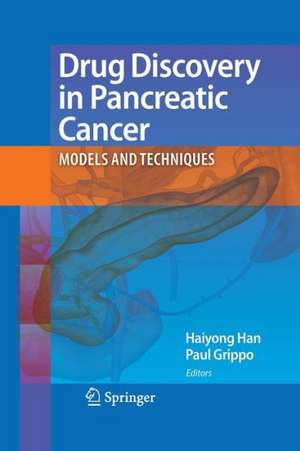Drug Discovery in Pancreatic Cancer: Models and Techniques
Editat de Haiyong Han, Paul Grippoen Limba Engleză Paperback – 25 noi 2014
Over the past decade, tremendous advances have been made in the field of cancer drug discovery, particularly, in the area of molecular and genetic models and technologies. Many of those advanced models and technologies have been applied to the drug discovery processes for pancreatic cancer. In this book, a team of experts will describe the latest development in the application of these models and technologies in pancreatic cancer. The authors include basic researchers as well as clinicians who work in the front-line of the war against pancreatic cancer and have the first-hand experience on these cutting-edge tools and techniques. The book can be divided into two general areas: 1) model systems and 2) genomics and proteomics tools. In recent years there have been a lot of advances in the model systems for pancreatic cancer, including the further characterization of normal and cancerous pancreatic cell lines, the establishment of transgenic mouse models that recapitulate the initiation and progression of human pancreatic cancer, the development of a new xenograft model system for the evaluation of novel agents, and the establishment of a zebrafish pancreatic cancer model. The first four chapters of the book will be devoted to these models. The advances in genomics and proteomics research have made a major impact in cancer drug discovery. A number of these –omics-based tools and techniques have been applied in the pancreatic cancer drug discovery. Chapters 5-9 of the book will discuss techniques for genome-wide examination of gene expression, copy number, methylation, function and regulation. Chapters 10-11 will discuss in situ techniques for studying chromosomal and gene copy number abnormalities as well protein expression changes in cancer samples. Chapters 12-14 will focus on techniques for global examination of protein expression levels in biospecimens obtained from pancreatic cancer patients. Cancer drug discovery has become more and more target-centric.
| Toate formatele și edițiile | Preț | Express |
|---|---|---|
| Paperback (1) | 1095.54 lei 43-57 zile | |
| Springer – 25 noi 2014 | 1095.54 lei 43-57 zile | |
| Hardback (1) | 1101.21 lei 43-57 zile | |
| Springer – 17 mar 2010 | 1101.21 lei 43-57 zile |
Preț: 1095.54 lei
Preț vechi: 1153.19 lei
-5% Nou
Puncte Express: 1643
Preț estimativ în valută:
209.63€ • 219.46$ • 173.46£
209.63€ • 219.46$ • 173.46£
Carte tipărită la comandă
Livrare economică 07-21 aprilie
Preluare comenzi: 021 569.72.76
Specificații
ISBN-13: 9781489982759
ISBN-10: 1489982752
Pagini: 320
Ilustrații: XIX, 297 p.
Dimensiuni: 155 x 235 x 17 mm
Greutate: 0.45 kg
Ediția:2010
Editura: Springer
Colecția Springer
Locul publicării:New York, NY, United States
ISBN-10: 1489982752
Pagini: 320
Ilustrații: XIX, 297 p.
Dimensiuni: 155 x 235 x 17 mm
Greutate: 0.45 kg
Ediția:2010
Editura: Springer
Colecția Springer
Locul publicării:New York, NY, United States
Public țintă
Professional/practitionerDescriere
Pancreatic cancer is the fourth leading cause of cancer death in the United States. Every year, about 33,700 people in the United States will be diagnosed with pancreatic cancer and over 32,000 patients will die from the disease. The median survival of patients with advanced pancreatic cancer is about 6-months. This dismal picture of pancreatic cancer is mainly due to the lack of early diagnosis and effective treatment for patients with advanced disease. To increase the survival rate of pancreatic cancer patients, better tumor markers for diagnosis and new molecular targets for drug development are desperately needed. A lot of effort has been made in searching for pancreatic cancer-causing genes or genes associated with progression of malignant behavior in pancreatic cancer. As a result, alterations in the expression of several cancer-related genes have been identified in pancreatic tumors. The identification and characterization of these cancer-related genes have significantly increased our understanding of pancreatic cancer development, but unfortunately the treatment of pancreatic cancer has not advanced as much in the past 20 years.
Over the past decade, tremendous advances have been made in the field of cancer drug discovery, particularly, in the area of molecular and genetic models and technologies. Many of those advanced models and technologies have been applied to the drug discovery processes for pancreatic cancer. In this book, a team of experts will describe the latest development in the application of these models and technologies in pancreatic cancer. The authors include basic researchers as well as clinicians who work in the front-line of the war against pancreatic cancer and have the first-hand experience on these cutting-edge tools and techniques. The book can be divided into two general areas: 1) model systems and 2) genomics and proteomics tools. In recent years there have been a lot of advances in the model systems for pancreatic cancer, including the further characterization of normal and cancerous pancreatic cell lines, the establishment of transgenic mouse models that recapitulate the initiation and progression of human pancreatic cancer, the development of a new xenograft model system for the evaluation of novel agents, and the establishment of a zebrafish pancreatic cancer model. The first four chapters of the book will be devoted to these models. The advances in genomics and proteomics research have made a major impact in cancer drug discovery. A number of these –omics-based tools and techniques have been applied in the pancreatic cancer drug discovery. Chapters 5-9 of the book will discuss techniques for genome-wide examination of gene expression, copy number, methylation, function and regulation. Chapters 10-11 will discuss in situ techniques for studying chromosomal and gene copy number abnormalities as well protein expression changes in cancer samples. Chapters 12-14 will focus on techniques for global examination of protein expression levels in biospecimens obtained from pancreatic cancer patients. Cancer drug discovery has become more and more target-centric.
Over the past decade, tremendous advances have been made in the field of cancer drug discovery, particularly, in the area of molecular and genetic models and technologies. Many of those advanced models and technologies have been applied to the drug discovery processes for pancreatic cancer. In this book, a team of experts will describe the latest development in the application of these models and technologies in pancreatic cancer. The authors include basic researchers as well as clinicians who work in the front-line of the war against pancreatic cancer and have the first-hand experience on these cutting-edge tools and techniques. The book can be divided into two general areas: 1) model systems and 2) genomics and proteomics tools. In recent years there have been a lot of advances in the model systems for pancreatic cancer, including the further characterization of normal and cancerous pancreatic cell lines, the establishment of transgenic mouse models that recapitulate the initiation and progression of human pancreatic cancer, the development of a new xenograft model system for the evaluation of novel agents, and the establishment of a zebrafish pancreatic cancer model. The first four chapters of the book will be devoted to these models. The advances in genomics and proteomics research have made a major impact in cancer drug discovery. A number of these –omics-based tools and techniques have been applied in the pancreatic cancer drug discovery. Chapters 5-9 of the book will discuss techniques for genome-wide examination of gene expression, copy number, methylation, function and regulation. Chapters 10-11 will discuss in situ techniques for studying chromosomal and gene copy number abnormalities as well protein expression changes in cancer samples. Chapters 12-14 will focus on techniques for global examination of protein expression levels in biospecimens obtained from pancreatic cancer patients. Cancer drug discovery has become more and more target-centric.
Cuprins
Chapter 1: Pancreatic cancer cell line modelsSteven Warner, Ph.D. Translational Genomics Research InstituteDivision of Clinical Translational ResearchChapter 2: Pancreatic cancer xenograft models Manuel Hidalgo, M.D., Ph.D.Johns Hopkins University School of MedicineChapter 3: Pancreatic cancer transgenic mouse modelsDavid A. Tuveson M.D., Ph.D.Cancer Research UK Cambridge Research InstituteChapter 4: Pancreatic cancer zebra fish modelsSteven Leach, M.D.Division of Surgical OncologyJohns Hopkins University School of MedicineChapter 5: DNA microarray expression profilingCharles Gawad, M.D. School of MedicineUniversity of California at Los AngelesChapter 6: Array CGH profilingRobert Lucito, Ph.D.Cold Spring Harbor LaboratoryChapter 7: High throughput siRNASpyro Mousses, Ph.D.Division of Pharmaceutical Genomics Translational Genomics Research InstituteChapter 8: miRNA profilingGlen J. Weiss, M.DUniversity of Colorado Health Science CenterDepartment of Hematology and Medical OncologyChapter 9: Methylation detection and epigeneticsBernard W. Futscher, Ph.D.Arizona Cancer CenterChapter 10: Tissue microarray based IHC and FISHAnirban Maitra, MBBSThe Sol Goldman Pancreatic Cancer Research Center Johns Hopkins University School of MedicineChapter 11: Spectral Karyotyping (SKY) and M-FISHThomas R. Dennis, Ph.D.Translational Genomics Research InstituteChapter 12: Proteomics analysis of serum and pancreatic juiceMichael Goggins, M.D.The Sol Goldman Pancreatic Cancer Research CenterThe Johns Hopkins University School of MedicineChapter 13: Glycomics analysis of serum and pancreatic juice samplesJ. Michael Pierce, Ph.D.University of GeorgiaDirector, UGA Cancer CenterChapter 14: Protein arrays for pancreatic cancer researchRaoul Tibes, M.D.Division of Pharmaceutical Genomics Translational Genomics Research InstituteChapter 15: Vaccines for pancreatic cancerDan A. Laheru, M.D.Buntings Blaustein Cancer Research Building Room G89 Chapter 16: Molecular imaging of small animalsRobert J. Gillies, Ph.D.Department of Radiology Arizona Cancer Center, MRB 138Chapter 17 : Development of pharmacodynamic endpoint models for the evaluation of clinical activities of targeted therapeuticsAmanda Baker, Ph.D.Arizona Cancer Center
Textul de pe ultima copertă
Over the past two decades, tremendous advances have been made in the field of cancer drug discovery, particularly in the area of molecular and genetic models and technologies, many of which have been or are beginning to be applied to the drug discovery process for pancreatic cancer. Drug Discovery in Pancreatic Cancer: Models and Techniques offers the latest development in the application of those models and technologies in pancreatic cancer. The authors include experts in their perspective field of research including basic scientists as well as clinicians who work on the frontline in the war against pancreatic cancer and have first-hand experience employing these cutting-edge tools and techniques. The book progresses logically from modeling systems to genomic profiling, proteomic analysis, and pharmacodynamic assays. It features: •Up-to-date survey of many cell lines and animal models of pancreatic cancer and their applications in drug discovery.•Application of fluorescent mouse models in pancreatic cancer drug discovery.•Utility of cutting-edge genomics, proteomics, epigenomics, and glycomics methodologies for molecular target identification and validation.•Discussion of microRNA profiling and high throughput RNAi screening for pancreatic cancer drug discovery.•Broad screening technologies for proteins and nucleic acids using tissue microarrays and CGH arrays.•Development of pharmacodynamic endpoint assays for targeted therapeutics.Comprehensive and practical Drug Discovery in Pancreatic Cancer: Models and Techniques offers both basic and clinical scientists who are interested in pancreatic cancer an up-to-date review and assessment of models and technologies being applied in drug discovery for pancreatic cancer. The true premise of this book is to provide a guide for drug discovery and evaluation, with consideration of various modeling systems and the methods for screening/profiling responses to these compounds. It is the Editors intent to stimulate new thought in this area of research as a means of generating much improved drug efficacy for greater survival and quality of life for patients battling pancreatic cancer.
Caracteristici
This has made the development of pharmacodynamic endpoint assays and the small animal imaging models ever more important
The last two chapters of the book will review the recent developments in this area
The last two chapters of the book will review the recent developments in this area













